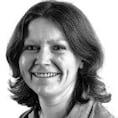Considering people in wheelchairs as the only ones who need extra help if a building goes on fire is not enough according to Marnie Peters, a Canadian expert in building accessibility and safe evacuation procedures in Dublin this week for the Fire Safety For All conference.
"We use the term 'people with activity limitations', because it includes people who won't say they have a disability. It will include a rugby player with a broken leg, a heavily pregnant woman, a grandmother who wears glasses and is hard of hearing but doesn't consider herself to have a disability," says Peters.
This definition is important when Peters is teaching firefighters evacuation skills for all people with activity limitations. It also automatically includes people with physical disabilities who are wheelchair users.
“Firefighters will often say: ‘We know all about how to deal with people with disabilities.’ But they haven’t thought about how they will communicate with a deaf person or how they will help someone with a learning disability who becomes anxious and fearful and is more likely to hide than move to a safe location.”
Helping someone with a learning disability become calm and giving one instruction at a time can save time and stress later, according to Peters. Allowing someone with a wheelchair use a lift in an emergency situation also means that person has his own personalised wheelchair when outside the building rather than being dependent on someone else at that point.
“Fire safety is not just for one group of people. It’s about architects designing buildings that are accessible and easy to evacuate,” says Peters.
“But it’s also about people themselves having personal plans about how to leave a building in an emergency. People need to know where to go when waiting for firefighters. There needs to be enough space for two wheelchairs. It can’t be just an area under the stairs.”
A wheelchair user following a car crash over 20 years ago, Peters is personally tuned into the need for safe evacuation procedures. “When I was a university student, the fire alarm went off and someone was assigned to stay with me but left. When the fire fighter finally arrived, he said: ‘What the hell are you doing sitting here by yourself?’ What was I supposed to do?”
Following her degree in economics and law, Peters became involved in disability- inclusive emergency preparedness. At the conference, she also launched a universal sign language of 10 key signs to communicate with deaf people in emergency evacuation. “There are certain signs that are naturally intuitive, so they won’t require formal training. I’m hoping delegates will go away with these and spread them around the world.”









